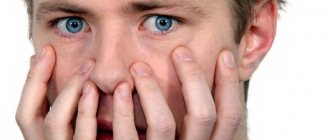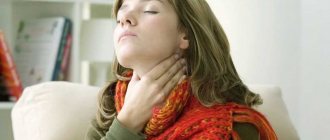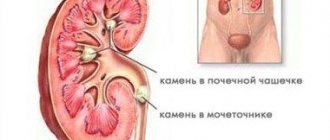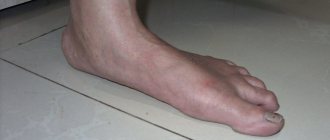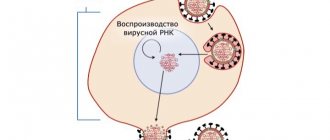Reasons for virus activation
The triggering factor for the proliferation of Varicella zoster and its release from the nerve ganglia is considered to be a decrease in the body’s immune defense. Physiological suppression of the immune system is observed in older people, and temporary disturbances in the functioning of the immune system occur with acute and chronic diseases, stress, poor low-calorie diet, mental and physical stress.
Patients at risk are:
● with congenital and acquired immunodeficiencies;
● taking immunosuppressive therapy;
● receiving courses of chemoradiotherapy;
● have undergone bone marrow transplantation or internal organ transplantation.
Herpes zoster (shingles) - symptoms and treatment
There is no incubation period in the usual sense, since herpes zoster is not a primary infection. A whole life can pass, and the manifestation will still occur, although the virus is present in the body.
It is difficult to predict the development of the disease. Its onset and manifestations vary widely and depend on the severity. The disease may be preceded by stress, trauma or acute respiratory infections.
The symptoms of individual forms of herpes zoster are distinguished.
Gangliocutaneous form
This form begins with a prodrome - mild malaise, sensory disturbances, moderate pain in the areas of future rashes. This period lasts up to seven days. Then the pain becomes severe, fever appears, and a moderately severe syndrome of general infectious intoxication appears. Sometimes the pain intensifies even when the wind blows (so-called allodynic pain - from non-painful stimuli).
After 3-10 days, a vesicular rash appears in these places against a background of redness. In this case, the intensity of pain usually decreases. The rash occurs on one side, limited to the area of innervation of one sensory ganglion. Vesicles tend to cluster.
Subsequently, the contents of the vesicles become cloudy and sometimes burst open. After 4-5 days from the appearance of the rash, crusts appear. They disappear after 2-4 weeks of illness.
Rashes are allowed without a trace, but only in the absence of scratching and deep inflammatory damage. But pain phenomena can persist for a long time, sometimes up to a year. This requires timely antiviral therapy and pain relief.
In general, the pain with herpes zoster is quite pronounced and intensifies with movement or touch (even a slight one). They can be classified as acute (from prodrome to one month), subacute (1-4 months) and chronic (more than 4 months - postherpetic neuralgia - typical neuropathic pain). The nature of the pain can be different - constant and spontaneous, often burning, pressing. Sometimes the pain is compared to an electric shock. They can cause significant physical suffering to patients, disrupt sleep, and exhaust the patient.
The localization of pain and rash corresponds to the projection of the affected nerves.
Eye shape
Rashes appear on the face, nose and eyes. This is due to damage to the trigeminal nerve and gasserian ganglion. The rash spreads from the level of the eye to the parietal region, abruptly stopping along the midline of the forehead. Sometimes the process affects the eye.
Ear shape
The geniculate node is affected. In this case, the auricle and external auditory canal are captured. Paralysis of the facial nerve and facial muscles may occur - the so-called. Hunt's syndrome. Taste sensitivity is lost.
Gangrenous (necrotic) form
Deep skin damage occurs. Rough scars form, sometimes with hemorrhagic impregnation of the contents - hemorrhagic form. Most often it develops in older people with a complicated somatic history - diabetes mellitus, peptic ulcer, etc.
Meningoencephalitic form
It is more often observed when the rash is located on the head. The temperature rises, headaches, nausea and vomiting occur, which does not bring relief, meningeal syndrome, impaired consciousness, coma. The mortality rate for this condition is over 60%.
Disseminated form
Occurs with AIDS. The rash spreads throughout the entire skin. Often this affects internal organs - lungs, brain, liver, kidneys. The prognosis is unfavorable.
Ganglioneuralgic form
There are no characteristic rashes, but there is obvious pain. Diagnosis is extremely difficult. Due to the very late diagnosis, treatment is limited to pain relief only. The use of antiviral drugs in the delayed period clearly does not affect the process.
Herpes zoster during pregnancy
In pregnant women, herpes zoster (in the absence of HIV) usually does not have any differences. It does not affect the course of pregnancy and does not cause damage to the fetus/child[2][3][6][8][10].
How to recognize herpes zoster?
The disease begins with prodromal phenomena: malaise, increased body temperature, decreased performance. Patients complain of tingling, numbness, burning in limited areas of the skin, in the area of which severe pain occurs after a few days.
The period of advanced clinical manifestations begins with a sharp rise in temperature. Against the background of fever, pink spots with a diameter of up to 5 mm appear on the skin, which within a day turn into bubbles with transparent contents, and then shrink into crusts. The rashes are located on one side of the body, most often on the skin of the chest or face. They have a characteristic localization due to the course of the affected nerve.
Towels, bed, linen
When the pathogen is activated, planned surgical interventions are contraindicated, so you can find out the prices for mole removal, but you will have to wait a bit with the manipulation itself. Firstly, a person in this phase experiences a lot of unpleasant sensations: burning, itching, hypersensitivity of the skin - there is no need to increase the discomfort. Secondly, at the stage of the appearance of vesicles with serous fluid, the patient is contagious, so it is better to limit contact with him.
To avoid infecting family members during the period of rashes, the patient should avoid close hugs and do not allow other people to use their towels for their hands, face and body. Bed linen should be free of starch and made of 100% cotton: this absorbs liquid from burst bubbles well. For the same reason, cotton underwear is also preferable.
Atypical forms of the disease
In some cases, the course of herpes zoster differs from the classical pattern, which makes timely diagnosis difficult. There are several forms of Herpes zoster:
1. Abortive. It has minimal clinical manifestations: malaise, weakness, redness and swelling of the skin without rashes. The duration of the illness does not exceed several days.
2. Bullous. Skin symptoms include flaccid blisters the size of a pea or larger, which are filled with clear fluid. This type of herpes zoster is accompanied by severe intoxication.
3. Hemorrhagic. Develops in patients with a suppressed immune system. In this case, the lesion affects the deep layers of the skin: the blisters are filled with bloody contents, and dark brown crusts appear.
4. Gangrenous. Another variant of Herpes zoster, typical for elderly and weakened patients. Skin inflammations do not heal for a long time, turning into ulcers that leave behind rough scars.
5. Generalized. It is characterized by the spread of a herpetic rash over a large area of skin beyond the zone of innervation of one nerve. This form is observed in immunocompromised patients.
Methods of treating the disease
Herpes zoster on the face and other areas is treated on an outpatient basis. Inpatient treatment is required only for the generalized form, as well as complications.
The peculiarity of therapy is its complexity - taking antiviral and immunostimulating medications.
Therapy involves relieving intoxication and pain, preventing the progression of infection. For secondary bacterial infections, antibiotics are used. To relieve rashes, use brilliant green and 5% dermatol ointment locally. If the process is sluggish, the doctor may prescribe metacil ointment or solcoseryl.
For herpes zoster on the neck or other areas, physiotherapeutic procedures are also sometimes prescribed.
Diet is important for the effectiveness of therapy. Exclude from the diet:
- fat meat;
- animal fats;
- spicy foods.
Which doctor should I contact?
For classic herpes zoster with skin rashes, a consultation with an ID-Clinic dermatologist is required. The doctor will conduct an initial diagnosis and, if necessary, give a referral to a neurologist or infectious disease specialist. To make a diagnosis, the patient will need to undergo an extensive examination.
Taking into account the results obtained, the doctor selects an individual treatment regimen using antiherpetic drugs, painkillers and other medications. With timely initiation of therapy, the prognosis is favorable.
Therapeutic baths
If the patient is determined to remove flat warts or other skin formations, then he first needs to put herpes zoster into remission. To do this, in some situations, the doctor prescribes not only medications, but also medicinal baths. You should understand their difference from hygienic ones:
- The water temperature corresponds to body temperature.
- Acceptance time is 15-20 minutes.
- No detergents are used.
For this procedure, essential oils that neutralize the virus, such as pine, are used. Tea tree and sage oils are also added - they relieve inflammation and promote healing of rashes.
Methods for preventing herpes zoster
In patients with reduced immunity, in case of contact with a patient with chickenpox, it is recommended to administer human immunoglobulin or immune plasma. The drugs reduce the risk of developing shingles, but they are most effective when used within the first 96 hours after exposure.
Vaccination against herpes zoster with the Zostavax vaccine can be carried out in people over 60 years of age. It is performed once and reduces the risk of developing Herpes zoster by 51%, and also reduces the intensity of pain by 61%, and the likelihood of postherpetic neuralgia by 66.5%.
Rules for water procedures
- Take a shower rather than a bath to avoid spreading the infection to other areas of the skin.
- Wash once every two days to reduce irritation to areas of inflammation.
- The water should not be hot, and in no case should you create a “steam room” (by the way, visiting a sauna is also contraindicated).
- Do not rub yourself with a washcloth, do not use a scrub, because multiple damage to the bubbles can lead to bacterial complications.
- Detergents are needed with a neutral pH of 5.5 - they are gentle on the epidermis.
Causes and risk factors
The cause of shingles is the third type of herpes virus. This virus causes chickenpox. Chickenpox usually affects children; the disease is rare in adults. After chickenpox, the virus remains in the body for life.
It moves to the nerve ganglia, where it remains in an inactive state for a long time, without causing any symptoms. When the body weakens and is exposed to provoking factors, the virus becomes more active. It reaches the skin along the nerve fibers, where a rash forms. Moving along the nerve fibers, the virus destroys them, which is why pain occurs.
You cannot get shingles from another person. The disease will only occur if a person has had chickenpox and the virus remains in his body. Shingles is not transmitted by airborne droplets. But there is one nuance here. A person with shingles is dangerous to people who have not had chickenpox.
If a person with shingles comes into contact with a person who has not had chickenpox, the latter will develop chickenpox. But here you need quite close contact. The virus in lichen is found only in the skin and is not spread by airborne droplets.
Reasons for the activation of the virus:
- a sharp decrease in immunity - after a serious illness, with cancer, HIV infection;
- severe or frequent overheating - visiting a bathhouse or sauna, climate change;
- hypothermia;
- prolonged exposure to the sun or solarium;
- severe stress.
Shingles reoccurs extremely rarely. Relapses can occur in people with active autoimmune diseases or HIV infection without taking antiretroviral drugs. Repeated cases also occur in people with cancer, and the rash often corresponds to the location of the tumor. There is no chronic form of herpes zoster; this disease is always acute.
Shingles is classified according to the nature of its course:
- typical;
- atypical.
According to severity:
- light;
- moderate severity;
- heavy.
There are fulminant and protracted course of the disease. Shingles also occurs with or without complications.
Screening for herpes zoster
Diagnosis of shingles is not difficult, since the rash has a very characteristic appearance. The fact of chickenpox suffered in childhood and the presence of provoking factors are important.
To confirm atypical forms:
- blood for antibodies to the herpes virus type 3 - class M antibodies (igM) appear;
- blood test using PCR method - the virus itself is detected;
- general blood test - the number of leukocytes increases mainly due to lymphocytes, the ESR increases.
To diagnose complications in the brain, computed tomography or magnetic resonance imaging is performed.
Causes of exacerbation of herpes
When self-treating herpes, there is a chance of relapse. Incorrect selection of a course of therapy suppresses the virus temporarily. The occurrence of relapses is provoked by the following factors:
- Re-infection after interaction with a sick person.
- Reduced immunity.
- Prolonged hypothermia of the body.
- Exposure to direct sunlight.
- Microtraumas of the skin and mucous membranes.
- Physical fatigue, lack of sleep.
- Nervous overstrain.
- Women have menstruation.
Most people infected experience relapses once or twice a year. With weak immunity, relapses are possible 5–20 times a year. This is how recurrent herpes type 1 manifests itself, treatment of which is possible only under the supervision of a doctor.

